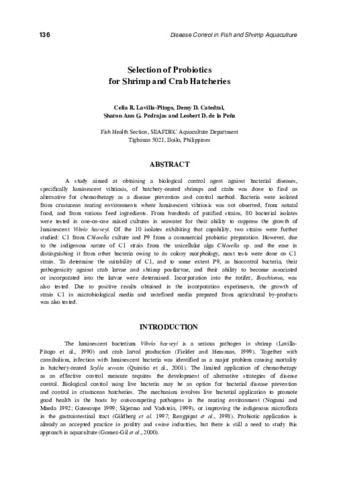Selection of probiotics for shrimp and crab hatcheries
- Global styles
- MLA
- Vancouver
- Elsevier - Harvard
- APA
- Help

ดู/
Downloads: 2,047
วันที่
2002Page views
7,511AGROVOC keyword
Taxonomic term
เมตาดาต้า
แสดงระเบียนรายการเต็ม
Share
นามธรรม
A study aimed at obtaining a biological control agent against bacterial diseases, specifically luminescent vibriosis, of hatchery-reared shrimps and crabs was done to find an alternative for chemotherapy as a disease prevention and control method. Bacteria were isolated from crustacean rearing environments where luminescent vibrosis was not observed, from natural food, and from various feed ingredients. From hundreds of purified strains, 80 bacterial isolates were tested in one-on-one mixed cultures in seawater for their ability to suppress the growth of luminescent Vibrio harveyi. Of the 10 isolates exhibiting that capability, two strains were further studied: C1 from chlorella culture and P9 from a commercial probiotic preparation. However, due to the indigenous nature of C1 strain from the unicellular alga Chlorella sp. and the ease in distinguishing it from other bacteria owing to its colony morphology, more tests were done on C1 strain. To determine the suitability of C1, and to some extent P9, as biocontrol bacteria, their pathogenicity against crab larvae and shrimp postlarvae, and their ability to become associated or incorporated into the larvae were determined. Incorporation into the rotifer, Brachionus, was also tested. Due to the positive results obtained in the incorporation experiments, the growth of strain C1 in microbiological media and unrefined media prepared from agricultural by-products was also tested.
การอ้างอิง
Lavilla-Pitogo, C. R., Catedral, D. D., Pedrajas, S. A. G., & De la Peña, L. D. (2002). Selection of probiotics for shrimp and crab hatcheries. In Y. Inui & E. R. Cruz-Lacierda (Eds.), Disease Control in Fish and Shrimp Aquaculture in Southeast Asia – Diagnosis and Husbandry Techniques: Proceedings of the SEAFDEC-OIE Seminar-Workshop on Disease Control in Fish and Shrimp Aquaculture in Southeast Asia – Diagnosis and Husbandry Techniques, 4-6 December 2001, Iloilo City, Philippines (pp. 136–150). Tigbauan, Iloilo, Philippines: SEAFDEC Aquaculture Department.
Type
Conference paperISBN
9718511601
Related items
Showing items related by title, author, creator and subject.
-
Polyculture of mud crab in Region 3
Bonifacio, Maurino (Aquaculture Department, Southeast Asian Fisheries Development Center, 2017)The polyculture of mud crab with one to three other species (milkfish (Chanos chanos), tilapia (Oreochromis spp.) and shrimp or sugpo (Penaeus monodon)) is a common practice in Region 3. Pond preparation is given importance ... -
Aqua-mangrove integrated farming: Shrimp and mud crab culture in coastal and inland tidal flats with existing reforested or natural growth of mangroves
Triño, Avelino T. (Aquaculture Department, Southeast Asian Fisheries Development Center, 2000)Throughout the tropics, mangroves are being destroyed at an increasing rate for the development of aquaculture ponds. In the Philippines, for instance, mangroves were about 400,000 to 500,000 ha in 1918 but were reduced ... -
Development of protocol for the production of hatchery-reared mud crab Scylla serrata juveniles for soft-shell crab farming
Quinitio, Emilia T. ; Libunao, Gardel Xyza; Parado-Estepa, Fe D. (Aquaculture Department, Southeast Asian Fisheries Development Center, 2017)
Development of economically viable techniques for growing hatchery-reared juvenile crabs to suitable sizes will address the problem on the source of seed stocks for soft-shell crab farming. This paper reports the production ...
; Libunao, Gardel Xyza; Parado-Estepa, Fe D. (Aquaculture Department, Southeast Asian Fisheries Development Center, 2017)
Development of economically viable techniques for growing hatchery-reared juvenile crabs to suitable sizes will address the problem on the source of seed stocks for soft-shell crab farming. This paper reports the production ...






